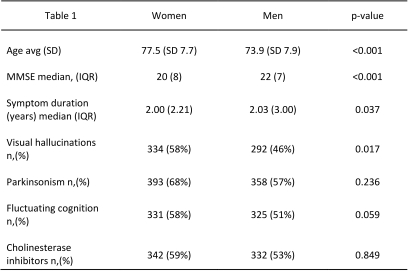Session Information
Date: Wednesday, June 22, 2016
Session Title: Cognitive disorders
Session Time: 12:00pm-1:30pm
Location: Exhibit Hall located in Hall B, Level 2
Objective: To describe demographic and clinical characteristics and use of cholinesterase inhibitors in women and men diagnosed with DLB.
Background: DLB seems to be more common in men than in women, but information is lacking on differences in clinical presentation of DLB between women and men.
Methods: Cross-sectional study including a cohort of 1208 patients from the multicenter European E-DLB consortium. Descriptive statistics for age, symptom duration and MMSE at the time of diagnosis are provided for women and men. The association between sex, use of cholinesterase inhibitors and presence of the core features of DLB, including visual hallucinations (VH), fluctuating cognition (FC) and parkinsonism were explored using logistic regression. Adjusted models included age, sex, and MMSE.
Results: Women numbered 576 (47.7%) of the cohort and were older at the time of diagnosis than men (mean age 77.5; SD 7.7 vs 73.9; SD 7.9). Median MMSE at the time of diagnosis was 20 in women (interquartile range—IQR 8) which was lower than in men (median 22; IQR 7). Symptom duration was significantly shorter in women, although this difference was slight (2.00 vs 2.03 years). Women were more likely to present visual hallucinations at the time of diagnosis (58 vs 46%) but did not significantly differ in presence of parkinsonism (68 vs 57%) or fluctuating cognition (58% vs 51% in men). The use of cholinesterase inhibitors was not significantly different (58% vs 51% in men).  After adjusting for age and MMSE, women were more likely to present visual hallucinations at baseline (OR 1.34; p-value 0.042), but there were no differences in fluctuating cognition (OR 0.875; p-value 0.356) or parkinsonism (OR 0.87; p-value 0.475). The likelihood of use of cholinesterase inhibitors was not different between the sexes (OR 1.02; p-value 0.891).
After adjusting for age and MMSE, women were more likely to present visual hallucinations at baseline (OR 1.34; p-value 0.042), but there were no differences in fluctuating cognition (OR 0.875; p-value 0.356) or parkinsonism (OR 0.87; p-value 0.475). The likelihood of use of cholinesterase inhibitors was not different between the sexes (OR 1.02; p-value 0.891).
Conclusions: This large multicenter study suggest that DLB is common also in women. Female DLB patients seemed to have a more rapid disease course, and more likely to present visual hallucinations.
To cite this abstract in AMA style:
S. Garcia-Ptacek, M.G. Kramberger, D. Aarsland. Gender differences in DLB: frequency, clinical presentation and treatment [abstract]. Mov Disord. 2016; 31 (suppl 2). https://www.mdsabstracts.org/abstract/gender-differences-in-dlb-frequency-clinical-presentation-and-treatment/. Accessed December 30, 2025.« Back to 2016 International Congress
MDS Abstracts - https://www.mdsabstracts.org/abstract/gender-differences-in-dlb-frequency-clinical-presentation-and-treatment/
